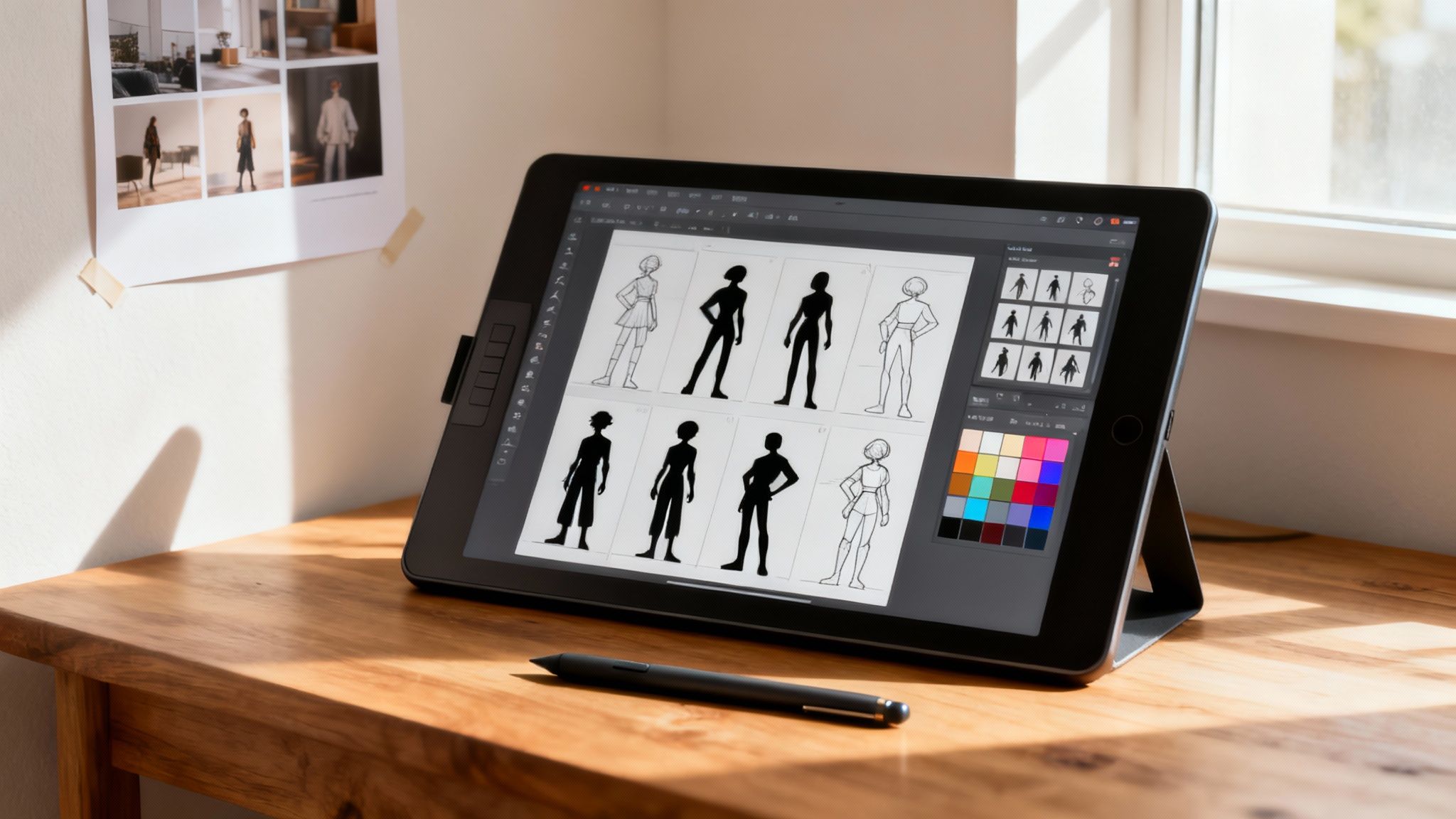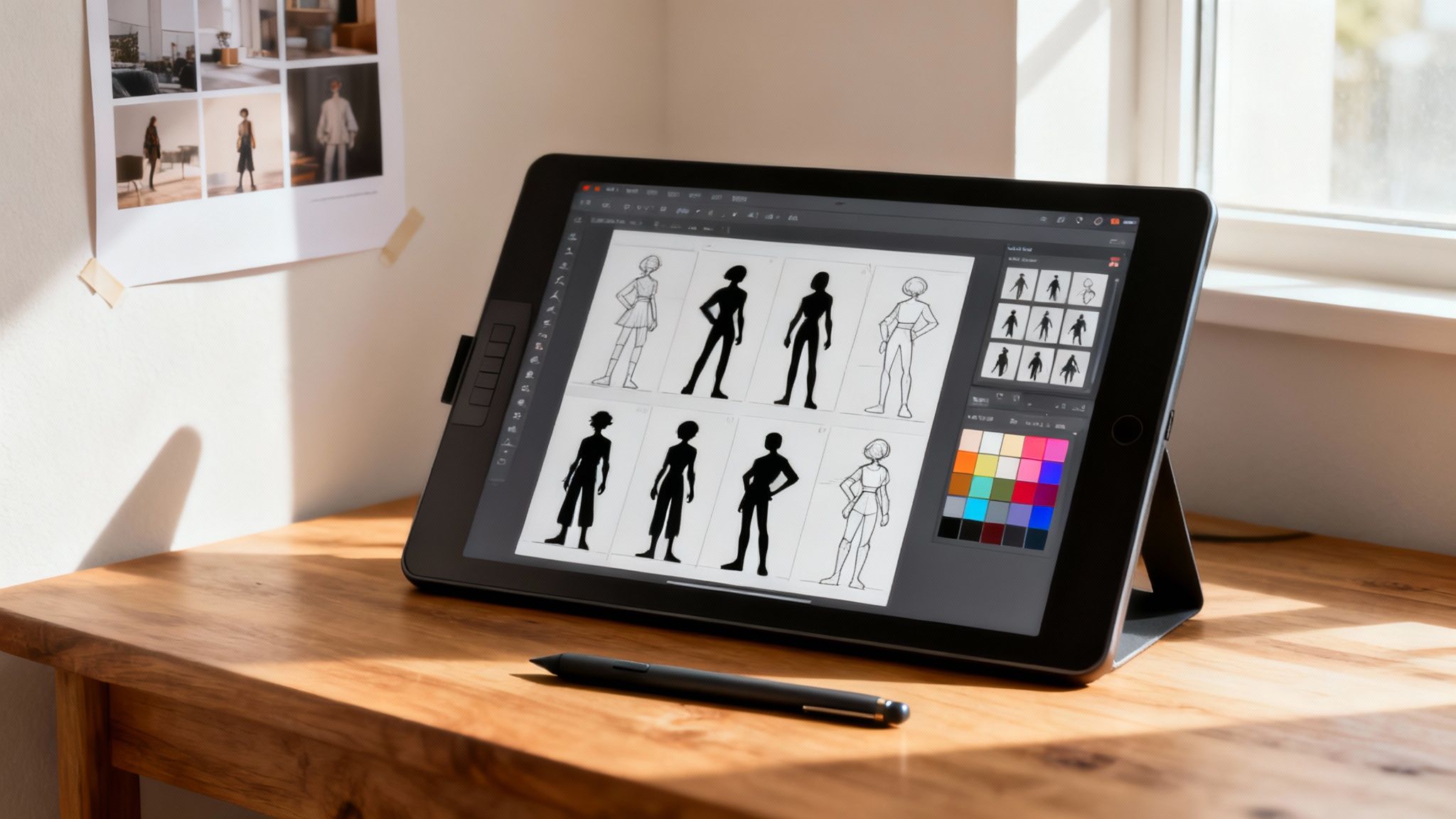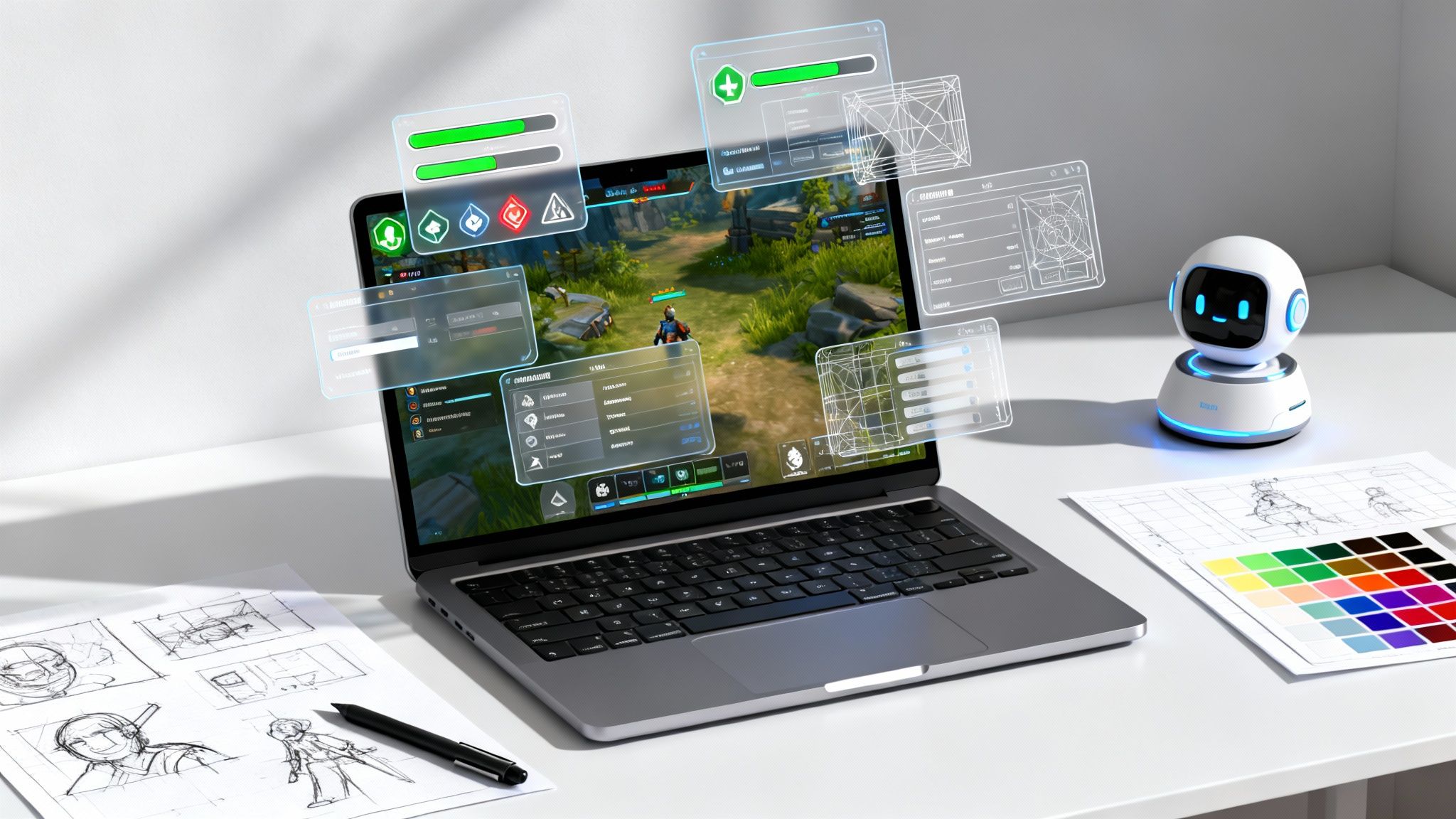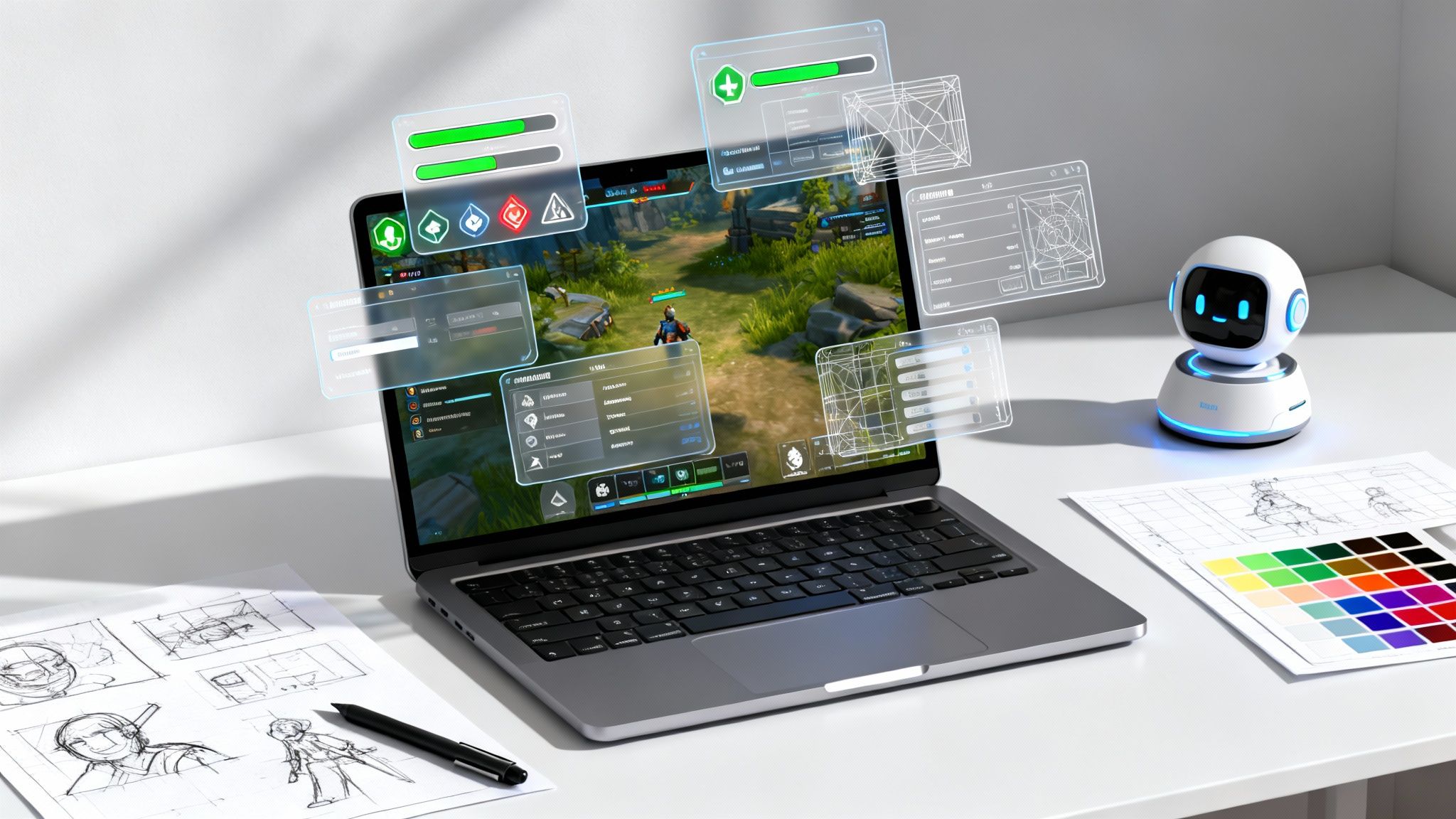To create a memorable 2D character is to do more than just draw; it's a journey from a spark of an idea to a polished, fully-realised design. It is a fusion of art and storytelling, blending personality, backstory, and visual appeal into a single cohesive whole, ready for animation, games, or illustration. To begin exploring your own ideas safely and effectively, we encourage you to try the Creative AI OS. If you haven't generated anything before, you can try it for free.
Building Your Character From the Inside Out
Every character that sticks in your memory started as an idea, not a sketch. Seriously. Before you even think about shapes or colours, you need to lay down a solid narrative foundation. A cool design is great, but a character with a real personality and clear motivations is what actually connects with people. This first phase is all about turning abstract thoughts into a design blueprint.
This means you need to go deeper than generic archetypes. What makes your character unique? Think about their history, their goals, and just as importantly, their flaws. Is your hero brave because they’ve always won, or because they’ve failed and gotten back up? Is your villain's scheming born from a lust for power, or from a deep-seated fear? Answering these questions gives your design purpose.
This brainstorming part can be a huge time sink. To speed things up without cutting corners, you can lean on AI tools for a bit of a creative jumpstart. For instance, Virtuall’s Creative AI OS can spin up detailed character backstories, personality traits, and visual mood boards from just a few simple prompts. It helps you explore different creative paths much faster. Feel free to try it for free and see how it fits your workflow.
Defining Core Traits
Once you've got a solid concept, it's time to boil it down to a few core traits. These will be your north star for every design decision you make from here on out. A character’s core traits are the bedrock of their entire visual identity.
- Personality: Are they cheerful or cynical? Timid or bold? Their personality will dictate their posture, expressions, and even how they dress.
- Motivation: What gets them out of bed in the morning? A character hell-bent on revenge is going to look and feel completely different from one searching for inner peace.
- Backstory: Where are they from? A character raised in a neon-drenched futuristic city will have a totally different vibe than one who grew up in a quiet, ancient forest.
This simple flow chart really nails how an idea grows into personality traits, which then shape the final design.

As you can see, the design itself is the last piece of the puzzle, built on the non-visual groundwork of idea and personality. It’s an approach that ensures every line and colour you choose has a reason for being there. For a much deeper look at how to apply this thinking to interactive media, check out our guide on game character design.
A character without a story is just a drawing. It’s the personality, the history, and the purpose you infuse into them that brings them to life and makes them memorable for your audience.
Mastering Silhouettes and Shape Language

Long before anyone notices the details of your character's costume or the look on their face, they see one thing: their outline. A character’s silhouette is their most immediate and powerful visual signature. It's the first read, the gut feeling that tells you who this person is in a single glance.
Think about it. The most memorable characters are instantly recognisable even when completely blacked out. That’s the power of a strong silhouette, and it’s all built on the simple, effective psychology of shapes.
The Power of Primary Shapes
At its heart, shape language is really straightforward, boiling down to three core forms. Grasping what these shapes communicate is the key to creating 2D characters that people connect with. Each one taps into subconscious associations you can use to build a personality from the ground up.
- Circles and Ovals: These feel soft, safe, and friendly. With no sharp edges, they come across as harmless and approachable—perfect for heroes, innocent sidekicks, or any character meant to be trusted.
- Squares and Rectangles: Solid, stable, and dependable. Squares convey strength, reliability, and sometimes a bit of stubbornness. They're the go-to for powerful protectors, imposing guards, or unshakeable authority figures.
- Triangles and Sharp Angles: Dynamic and aggressive. Those sharp points suggest danger, speed, and unpredictability. This makes them a natural fit for villains, cunning anti-heroes, or energetic, fast-moving protagonists.
Of course, the real magic happens when you start mixing and matching. A hero might have a square, powerful torso but a rounded face to signal their gentle nature. A villain could combine a triangular body with sharp, rectangular armour to appear both dangerous and immovable.
To get a better sense of how this works in practice, here’s a quick reference table.
Shape Psychology in Character Design
This table breaks down how basic shapes can instantly define a character’s role and personality before you’ve even drawn a single detail.
Using this as a starting point helps ensure your character’s design aligns perfectly with their story and role.
Developing a Recognisable Outline
Creating a strong silhouette isn't just about picking a shape; it's about making that shape clear and dynamic. A fantastic exercise is to fill your character's entire form with solid black. Can you still tell what they're doing? Can you sense their attitude? If so, you're on the right track.
Pay close attention to negative space—the empty areas around and between parts of your character. Clear negative space is what stops your silhouette from becoming a confusing blob, especially in action poses. Make sure arms aren't pressed flat against the body and that the legs are clearly distinct. This principle is fundamental everywhere, from animation to game design. To see how these ideas translate to a different medium, check out our deep dive on concept art for games.
The ultimate test of a great character design is whether it's identifiable from its shadow alone. If the silhouette tells a story, the rest of the details will only make it stronger.
This focus on strong visual storytelling is a hallmark of successful animation studios worldwide. For instance, the Danish animation scene, heavily influenced by top-tier schools like The Animation Workshop (TAW), champions collaborations that put narrative clarity first. This educational foundation has helped Danish studios produce 2D characters known for their creativity and immediate visual impact. By mastering silhouettes, you’re tapping into a universal design language valued across the globe.
Adding Life With Anatomy and Dynamic Posing

Once you've nailed down a strong silhouette, it’s time to breathe some life into that shape. This is where the fundamentals of anatomy and movement come in.
Even the most stylised or fantastical characters feel more believable when they’re grounded in reality. You don't need a medical degree—it’s about understanding the basics of proportion, balance, and weight. Get this right, and your character will feel like they could actually exist and move in their world, making their actions far more impactful.
Grounding Your Character in Reality
Consistency is everything. A simple way to keep your character’s anatomy in check is to build a basic mannequin or construction model. This isn’t fancy; it’s usually just a collection of simple ovals and cylinders that act as an underlying framework.
Think of it as your character’s skeletal blueprint. Once you establish the head-to-body ratio and limb lengths, you can refer back to this model to stop things from getting weird—like arms that mysteriously change length between panels.
Creating a simple mannequin isn’t about restricting creativity; it’s about building a reliable foundation. This framework frees you to focus on dynamic posing and expression without constantly worrying if the proportions look right.
With that consistent model in place, you can start exploring how your character carries their weight. Does their posture reflect their personality? A confident hero might stand tall, weight evenly distributed. A timid character, on the other hand, could be hunched over, looking perpetually off-balance.
Capturing Movement With Gesture and Posing
Anatomy gives you the structure, but gesture gives you the soul.
Gesture drawing is all about capturing movement and energy in just a few quick, fluid lines. It’s the total opposite of a stiff, static drawing. The goal is to find the "line of action"—a single, flowing curve that defines the entire pose.
Practising quick gesture drawings trains your eye to see the natural rhythm in a figure. It’s an essential skill for creating poses that do more than just show what a character looks like; they show who a character is.
- Dynamic Poses Tell a Story: A character leaning forward eagerly tells a completely different story than one leaning back defensively. Every pose needs a purpose.
- Avoid Symmetry: Perfectly symmetrical poses look rigid and unnatural. Break it up. Shift the character’s weight to one leg, tilt their shoulders, or turn their head. This classic "contrapposto" stance instantly adds a dose of naturalism.
- Guide the Viewer's Eye: Use your character’s limbs and gaze to direct attention. A well-composed pose leads the eye through the image, highlighting what’s important.
Ultimately, this is what elevates a design from a flat drawing to a living character. It's that blend of believable structure and expressive movement that makes them truly engaging.
Using Colour and Light to Tell a Story
Colour is so much more than decoration. It’s a storytelling shortcut. The right palette can telegraph a character’s personality, their mood, and even their background before a single line of dialogue is spoken. Nail this, and you transform a good drawing into an unforgettable character.
Getting a handle on basic colour theory—harmony, contrast, saturation—is what separates amateur work from professional design. Think about it. A fiery, rebellious hero just feels right in bold reds and oranges. A calm, wise mentor is instantly believable in cool blues and earthy greens. These aren't random choices; they’re deliberate decisions that reinforce the narrative you've already built with their backstory and silhouette.
Building a Colour Palette That Works
Creating a palette isn’t just about picking colours you like. It's about finding a combination that serves the character and their story. A character from a grim, dystopian future? You're probably looking at a desaturated, muted palette. A hero from a vibrant fantasy world? High-contrast and saturated colours will sell that feeling instantly.
Here’s a practical way I like to approach it:
- Find a Dominant Colour: This is the colour most tied to their core personality. It’s their signature.
- Add Secondary Colours: These support the main colour and are perfect for clothing, armour, or other key features.
- Pick an Accent Colour: Use this one sparingly. It's for drawing the eye to critical details, like their eyes or a magical amulet.
This simple structure keeps your design cohesive and visually strong.
A well-chosen colour palette doesn't just make a character look good. It sets the emotional tone and gives the audience crucial, unspoken cues about who they are and the world they come from.
The demand for this skill is exploding. Globally, the 2D animation software market hit around USD 35.64 billion in 2022 and is projected to rocket to USD 92.93 billion by 2030. That growth is driven by everyone from major studios to solo indie artists, all needing powerful visual storytelling to stand out.
Defining Form with Light and Shadow
Colour sets the mood, but light and shadow give your character form. This is what turns a flat shape into a figure that feels like it has weight and presence in the world. Shading makes them tangible.
Even basic shading can completely change a design. Just decide where your main light source is. That single decision dictates where every shadow will fall, carving out the character's features and defining their volume. Consistent lighting makes your character feel grounded and real.
To really get a feel for how light creates depth and focus, it’s worth studying real-world product photography lighting principles. The concepts translate directly to character art and can give you an incredible edge.
Refining Details for a Professional Finish
This is where the magic really happens. The final polish is what separates a good design from a great one. It’s all about obsessing over the tiny details that bring your character to life, making them feel intentional, cohesive, and ready for whatever project you throw at them. Think of it as stepping back, becoming your own toughest critic, and adding those final touches that scream professionalism.
Your line work is the perfect place to start. Clean, confident lines can instantly elevate a design, making it look crisp and deliberate. This means going back over your sketches to tame any wobbly lines, ensure your line weight is consistent where it needs to be, and using varied thickness to create a sense of depth and focus. I find that thicker lines work wonders for grounding a character, while thinner lines are best for delicate details like strands of hair or the folds in fabric.
Adding Believable Textures
Beyond clean lines, texture is what gives your character a tangible presence. It’s what makes metal look hard, fabric feel soft, and skin seem organic. You don’t need to render every single pore or thread, though. Often, subtle cues are far more effective.
- Subtle Noise: A light grain or noise filter is a great trick to break up flat colour surfaces, giving them a more natural, tactile quality.
- Material Indication: Use small details to hint at the material. A few strategically placed scratches and highlights can sell the idea of worn leather, while a soft, smooth gradient can suggest the feel of silk.
- Custom Brushes: Don't be afraid to experiment with custom brushes. They can save you a ton of time when adding textures like scales, fur, or wood grain without having to draw every detail by hand.
This level of detail is what makes a character feel truly grounded in their world. Across the creative industries, this polish is what sets professional work apart. For instance, in Denmark, statistical analyses show that even though many animation studios are small-scale, they maintain an incredibly high standard of quality in 2D character production—a real testament to the importance of refinement. You can dig deeper into the structure of the European animation industry in this report.
The Final Review and Turnaround Sheet
Before you pop the champagne, a final review is non-negotiable. Seriously, step away from your work for a while—an hour, a day, whatever it takes—and come back with fresh eyes. Check for consistency in your colours, anatomy, and overall style. Does the design still capture the personality you defined right at the start? Is the silhouette still clear and instantly readable?
The last 10% of the work is what separates a finished piece from a professional one. This is the time to be your own harshest critic and polish every element until it serves the character's story.
Finally, creating a character turnaround sheet is an absolute must for any character heading into animation or a team-based project. This sheet shows your character from multiple angles—typically front, side, three-quarter, and back views. It’s the blueprint that ensures anyone else working on the project can maintain perfect consistency.
This is also a critical asset for game development. If your character is destined for a game, the turnaround becomes the primary reference for creating sprites. To learn more about that specific workflow, you should check out our guide on how to make a sprite sheet. With this final asset package in hand, your character is truly project-ready.
Common Questions About Creating 2D Characters
Even with the best workflow, you're going to hit snags. It happens to everyone, whether you're just starting out or you’ve been doing this for years. Let’s break down a few of the most common hurdles I see artists run into.
A big one is, "How do I make my character feel unique?" The instinct is to just keep adding more—more accessories, more details, more complexity. But uniqueness usually comes from subtraction, not addition. Pick one or two defining features that really sell the character's core idea. Maybe it's a strange silhouette, a bold colour palette, or a single signature prop. Simplicity is almost always more memorable than complexity.
Then there’s the style question: "Should I stick to one style or experiment?" Building a consistent style is obviously great for your personal brand or a specific project. But don't box yourself in. Playing with different styles, especially on your own time, is like cross-training for an athlete. It strengthens your core skills and often leads to breakthroughs you’d never find otherwise.
Transitioning From 2D to 3D
I hear this a lot: artists are curious about making the jump from 2D to 3D, but the technical side feels intimidating. And they're not wrong—the learning curve for 3D modelling can be steep. You're suddenly dealing with polygons, UV maps, and rigging, which is a whole different world from drawing.
But here’s the thing: all your design fundamentals carry over perfectly. Your hard-won knowledge of shape language, anatomy, colour theory, and personality is the foundation for any great character, regardless of the medium. The trick is to start with tools that bridge that 2D-to-3D gap, rather than trying to master the most complex software from scratch on day one.
Think of 2D and 3D not as separate disciplines, but as different tools to bring the same vision to life. Your 2D skills give you a massive head start in creating compelling 3D characters.
Preparing Characters for Specific Platforms
"How do I change my character design for a comic versus an animation?" This is a crucial question, and the answer should guide you from the very beginning. Your character's final destination always dictates the design choices you make.
Take animation, for instance. A character built for movement needs a design that’s easy to draw consistently from any angle. Overly complex, asymmetrical details are a recipe for a production nightmare when you're drawing frame after frame.
On the other hand, a character for a single splash illustration can be loaded with intricate details. And if you're aiming for a vertical-scroll comic, you need to think about how the design reads in that format. You can find some great Webtoon creator resources that dive into designing specifically for that platform.
At the end of the day, creating 2D characters is a journey. Every single one you design teaches you something new and helps you find your voice as an artist.
Ready to accelerate your creative workflow and bring your character concepts to life faster than ever? The Virtuall Creative AI OS unifies asset generation, management, and collaboration in a single workspace. Move seamlessly from idea to final asset and empower your team. Start creating for free today.











